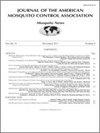关于轮换使用产品以控制犹他州盐湖城库蚊对来苏尼巴菌(Lysinibacillus sphaericus)的严重抗药性的案例报告。
IF 0.9
4区 农林科学
Q3 ENTOMOLOGY
引用次数: 0
摘要
盐湖城灭蚊区(SLCMAD)于 2016 年在盐湖城集水池中检测到库蚊对莱西尼巴氏杆菌(Lsph)产生了 20000 倍的抗药性。作为应对措施,盐湖城监测与防控中心暂停使用 Lsph,并在接下来的三年中轮换使用 spinosyn 和 s-methoprene 产品。第三年年底,再次对 Lsph 进行了评估,发现其药效与易感菌落菌株相似。在使用 Lsph 的第二年,技术人员观察到一些城市地点缺乏对幼虫的控制。2021 年期间进行的生物测定显示,在 SLCMAD 的城市地区,对 Lsph 产生了不同程度的抗药性。抗药性表型重新出现的速度之快,说明 SLCMAD 在短期内无法依靠重复使用 Lsph,即使在暂停使用三年并使用季节内产品轮换之后也是如此。其他研究小组之前的报告发现,尽管停止使用 Lsph 产品,但 Lsph 的长期选择并没有退步,SLCMAD 的情况也是如此。然而,我们的研究结果令人乐观地认为,回归可能相对较快。还需要进行更多的操作审查,未来的工作应确定田间种群中抗性等位基因的特征。总之,目前缺乏具体数据来支持相邻行业的普遍假设,而这些假设已被采用到灭蚊工作中。我们提供这份简短的说明,作为蚊虫和病媒控制区权衡 Lsph 抗药性补救方案的额外指导。本文章由计算机程序翻译,如有差异,请以英文原文为准。
A CASE REPORT ON PRODUCT ROTATION TO MANAGE SEVERE LYSINIBACILLUS SPHAERICUS RESISTANCE IN CULEX PIPIENS FROM SALT LAKE CITY, UTAH.
The Salt Lake City Mosquito Abatement District (SLCMAD) detected a 20,000-fold resistance to Lysinibacillus sphaericus (Lsph) in Culex pipiens occurring in catch basins of Salt Lake City during 2016. In response, SLCMAD suspended use of Lsph and rotated use of spinosyn and s-methoprene products for the next three years. At the end of the third year, Lsph was evaluated again and efficacy similar to susceptible colony strains. During the second year of Lsph use, technicians observed lack of control of larvae at some urban sites. Bioassays performed during 2021 showed recurrence of some resistance to Lsph to varying degrees across SLCMAD urban areas. The rapidity with which resistant phenotypes reemerged clarifies that SLCMAD cannot in the near future rely on repeated use of Lsph, even after suspending use for three years and using within-season product rotations. Prior reports in other research groups have found long-term selection to Lsph, as is the case at SLCMAD, to not regress in spite of halting use of the products. However, our findings offer some optimism that regression may be relatively quick. More operational review is needed, and future work should characterize resistance alleles in field populations. Collectively, there is a lack of concrete data supporting the prevailing assumptions from adjacent industries that were adopted into mosquito abatement. We provide this short note as additional guidance for mosquito and vector control districts weighing options to remediate Lsph resistance.
求助全文
通过发布文献求助,成功后即可免费获取论文全文。
去求助
来源期刊
CiteScore
2.10
自引率
10.00%
发文量
44
审稿时长
6-12 weeks
期刊介绍:
The Journal of the American Mosquito Control Association (JAMCA) encourages the submission
of previously unpublished manuscripts contributing to the advancement of knowledge of
mosquitoes and other arthropod vectors. The Journal encourages submission of a wide range of
scientific studies that include all aspects of biology, ecology, systematics, and integrated pest
management. Manuscripts exceeding normal length (e. g., monographs) may be accepted for
publication as a supplement to the regular issue.

 求助内容:
求助内容: 应助结果提醒方式:
应助结果提醒方式:


